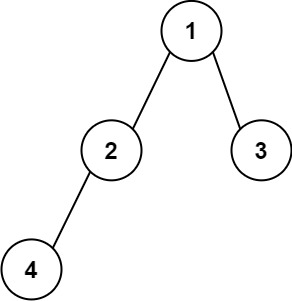Given the root node of a binary tree, your task is to create a string representation of the tree following a specific set of formatting rules. The representation should be based on a preorder traversal of the binary tree and must adhere to the following guidelines:
Node Representation: Each node in the tree should be represented by its integer value.
Parentheses for Children: If a node has at least one child (either left or right), its children should be represented inside parentheses. Specifically:
- If a node has a left child, the value of the left child should be enclosed in parentheses immediately following the node's value.
- If a node has a right child, the value of the right child should also be enclosed in parentheses. The parentheses for the right child should follow those of the left child.
Omitting Empty Parentheses: Any empty parentheses pairs (i.e.,
()) should be omitted from the final string representation of the tree, with one specific exception: when a node has a right child but no left child. In such cases, you must include an empty pair of parentheses to indicate the absence of the left child. This ensures that the one-to-one mapping between the string representation and the original binary tree structure is maintained.In summary, empty parentheses pairs should be omitted when a node has only a left child or no children. However, when a node has a right child but no left child, an empty pair of parentheses must precede the representation of the right child to reflect the tree's structure accurately.
Example 1:

Input: root = [1,2,3,4] Output: "1(2(4))(3)" Explanation: Originally, it needs to be "1(2(4)())(3()())", but you need to omit all the empty parenthesis pairs. And it will be "1(2(4))(3)".
Example 2:

Input: root = [1,2,3,null,4] Output: "1(2()(4))(3)" Explanation: Almost the same as the first example, except the()after2is necessary to indicate the absence of a left child for2and the presence of a right child.
Constraints:
- The number of nodes in the tree is in the range
[1, 104]. -1000 <= Node.val <= 1000
/** * Definition for a binary tree node. * struct TreeNode { * int val; * TreeNode *left; * TreeNode *right; * TreeNode() : val(0), left(nullptr), right(nullptr) {} * TreeNode(int x) : val(x), left(nullptr), right(nullptr) {} * TreeNode(int x, TreeNode *left, TreeNode *right) : val(x), left(left), right(right) {} * }; */ class Solution { public: string tree2str(TreeNode* t) { if(t == nullptr) return ""; if(t->left == nullptr && t->right == nullptr) return to_string(t->val); else if(t->right == nullptr) return to_string(t->val) + "(" + tree2str(t->left) + ")"; else return to_string(t->val) + "(" + tree2str(t->left) + ")" + "(" + tree2str(t->right) + ")"; } };
No comments:
Post a Comment